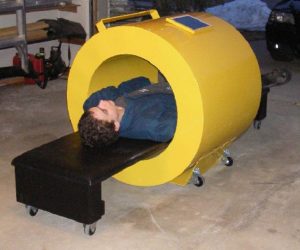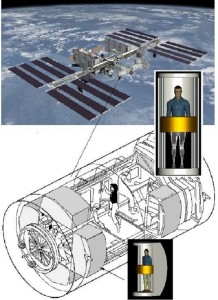On September 13, researchers from the University of Saskatchewan introduced a compact Magnetic Resonance Imager (MRI) at the annual conference organized by the American Institute of Aeronautics and Astronautics (AIAA). This smaller and cheaper version of the traditional MRI appears to be a suitable new tool to monitor the health of astronauts aboard the ISS and during possible future deep space missions.

The full-size mock-up of the MRI imager introduced on September 13 at the annual AIAA conference (Credits: Gordon Sarty/ University of Saskatchewan)
“I would like to build a facility-class, whole-body-sized MRI,” said Gordon Sarty, acting chairman of the biomedical engineering division at the University of Saskatchewan in Canada. “Such a project would require an agreement between the ISS space agencies.” Sarty believes he will be able to gain the support of the Canadian Space Agency to provide funding to go through with the project and launch it to the ISS by 2020.
The machine is capable of producing detailed “sliced” images of human bodies or their parts. Monitoring of bone and muscle loss processes or of the impacts of radiation during the long term space stay would therefore be much easier with the technology. The MRI in general uses radiofrequency coils that send signals to the organic tissue and receive the returning signal to build an image of the tissue’s inner structure.

The compact MRI device is very suitable to enhance the studies of astronauts’health (Credits: Gordon Sarty/ University od Saskatchewan).
Whereas the conventional MRI weighs about 11 tons, the mass of the compact one is less than 1 ton, making it much more space convenient. There are also other features enabling the use of the compact MRI in orbit or during space travel. Unlike the conventional MRI, the compact machine doesn’t rely on superconducting magnets that create stray magnetic fields that interfere with the electronic equipment aboard the spacecraft. Instead, the newly invented technology uses a permanent Halbach magnet that is much lighter than the superconducting coil and does not create any detrimental stray magnetic field. Also the energy consumption required to power the magnets is much lower than in the case of the coils.
Whereas the currently used MRI technology costs about $2 million, the compact version promises to cut the costs to only $200,000. The technology would be convenient for many terrestrial facilities: mobile medical centers in remote areas in developing countries or battlefield hospitals. However, the authors of the project believe that space is the right place to first deploy the technology: “Eventually someone will break a bone in space,” says Gordon Sarty. “We have no idea if that bone will heal.”
The principles of MRI are explained in the following video:
[youtube http://www.youtube.com/watch?v=H5q79R9C-mk&w=420&h=315]















































![A trajectory analysis that used a computational fluid dynamics approach to determine the likely position and velocity histories of the foam (Credits: NASA Ref [1] p61).](http://www.spacesafetymagazine.com/wp-content/uploads/2014/05/fluid-dynamics-trajectory-analysis-50x50.jpg)



Leave a Reply